Research Proposal: Government Subsidies for Solar Energy - Literature Review and Methodologies
VerifiedAdded on 2023/04/26
|12
|3289
|322
Assignment
AI Summary
In this assignment we will discuss about methodology and below are the summaries point:-
project is to explore past and current government subsidies and rebates available on solar energy, with a focus on the role of photovoltaic storage in amplifying the capability of PV systems to restore the active sources of conventional power.
Project scope The scope of this research project covers the literature review, research questions, research design and methodology.
potential findings, research limitations, and time schedule, with a specific focus on the topic of government subsidies and rebates available on solar energy.
Contribute Materials
Your contribution can guide someone’s learning journey. Share your
documents today.

0
Research Assignment
Research Assignment
Secure Best Marks with AI Grader
Need help grading? Try our AI Grader for instant feedback on your assignments.
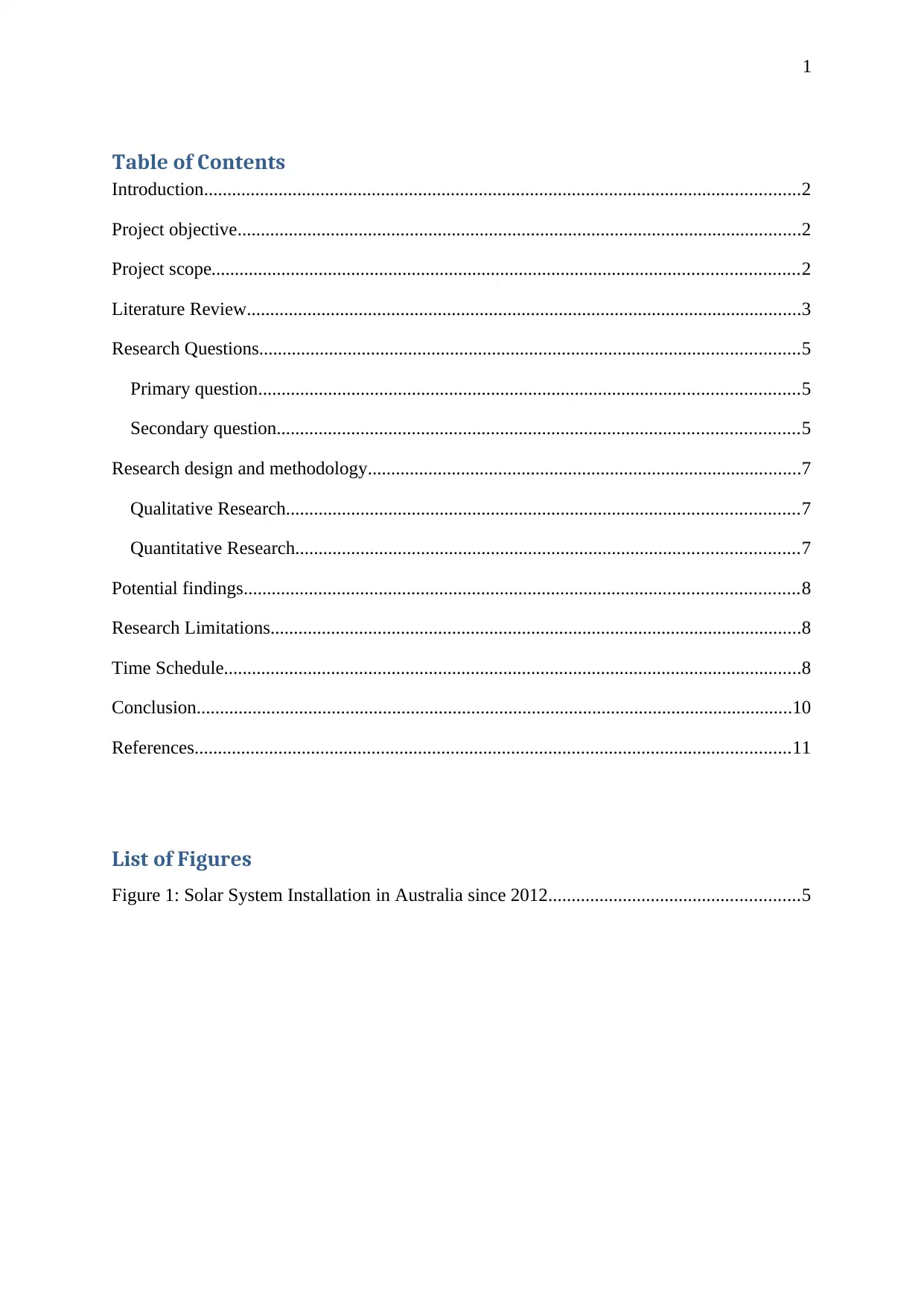
1
Table of Contents
Introduction................................................................................................................................2
Project objective.........................................................................................................................2
Project scope..............................................................................................................................2
Literature Review.......................................................................................................................3
Research Questions....................................................................................................................5
Primary question....................................................................................................................5
Secondary question................................................................................................................5
Research design and methodology.............................................................................................7
Qualitative Research..............................................................................................................7
Quantitative Research............................................................................................................7
Potential findings.......................................................................................................................8
Research Limitations..................................................................................................................8
Time Schedule............................................................................................................................8
Conclusion................................................................................................................................10
References................................................................................................................................11
List of Figures
Figure 1: Solar System Installation in Australia since 2012......................................................5
Table of Contents
Introduction................................................................................................................................2
Project objective.........................................................................................................................2
Project scope..............................................................................................................................2
Literature Review.......................................................................................................................3
Research Questions....................................................................................................................5
Primary question....................................................................................................................5
Secondary question................................................................................................................5
Research design and methodology.............................................................................................7
Qualitative Research..............................................................................................................7
Quantitative Research............................................................................................................7
Potential findings.......................................................................................................................8
Research Limitations..................................................................................................................8
Time Schedule............................................................................................................................8
Conclusion................................................................................................................................10
References................................................................................................................................11
List of Figures
Figure 1: Solar System Installation in Australia since 2012......................................................5
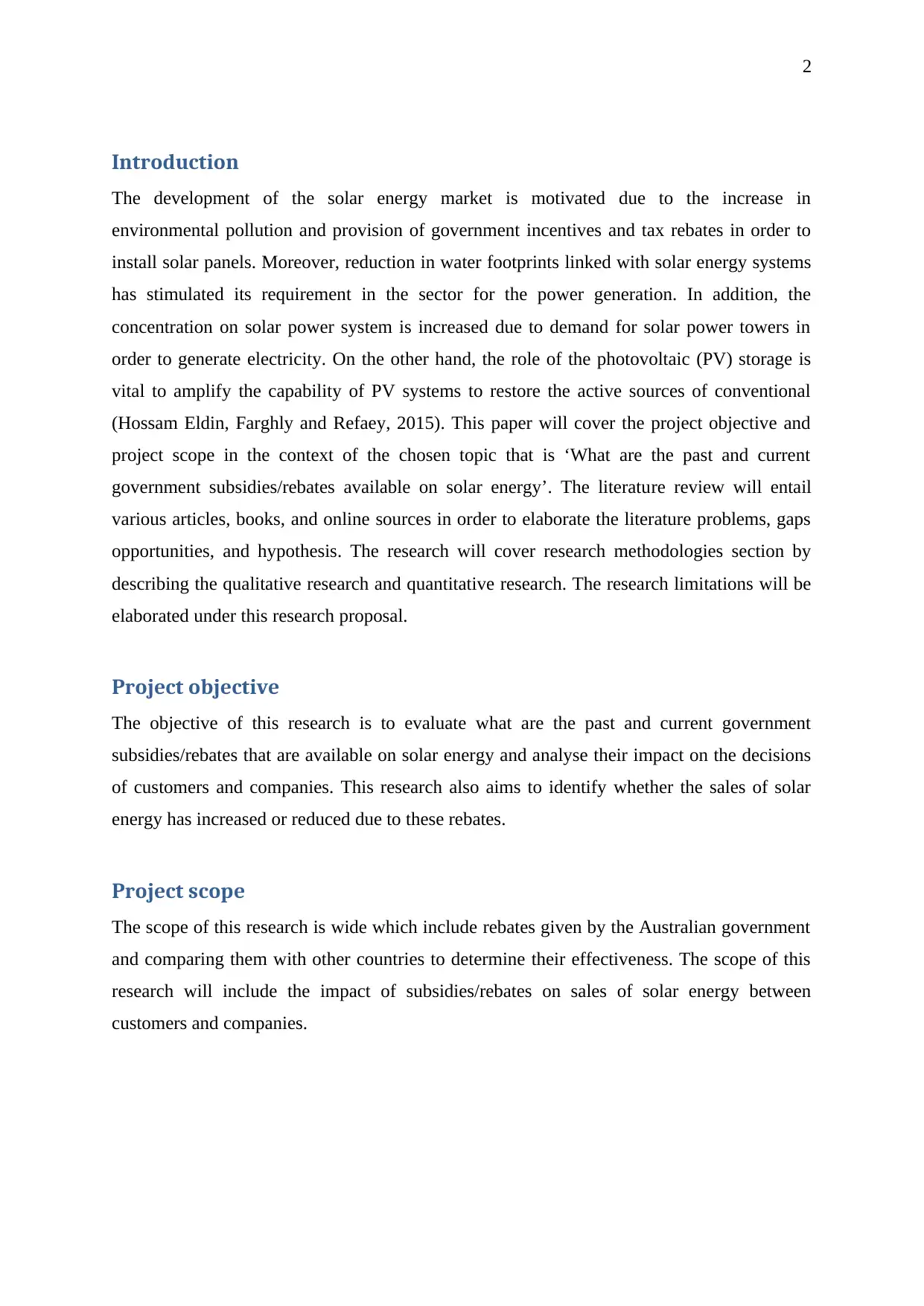
2
Introduction
The development of the solar energy market is motivated due to the increase in
environmental pollution and provision of government incentives and tax rebates in order to
install solar panels. Moreover, reduction in water footprints linked with solar energy systems
has stimulated its requirement in the sector for the power generation. In addition, the
concentration on solar power system is increased due to demand for solar power towers in
order to generate electricity. On the other hand, the role of the photovoltaic (PV) storage is
vital to amplify the capability of PV systems to restore the active sources of conventional
(Hossam Eldin, Farghly and Refaey, 2015). This paper will cover the project objective and
project scope in the context of the chosen topic that is ‘What are the past and current
government subsidies/rebates available on solar energy’. The literature review will entail
various articles, books, and online sources in order to elaborate the literature problems, gaps
opportunities, and hypothesis. The research will cover research methodologies section by
describing the qualitative research and quantitative research. The research limitations will be
elaborated under this research proposal.
Project objective
The objective of this research is to evaluate what are the past and current government
subsidies/rebates that are available on solar energy and analyse their impact on the decisions
of customers and companies. This research also aims to identify whether the sales of solar
energy has increased or reduced due to these rebates.
Project scope
The scope of this research is wide which include rebates given by the Australian government
and comparing them with other countries to determine their effectiveness. The scope of this
research will include the impact of subsidies/rebates on sales of solar energy between
customers and companies.
Introduction
The development of the solar energy market is motivated due to the increase in
environmental pollution and provision of government incentives and tax rebates in order to
install solar panels. Moreover, reduction in water footprints linked with solar energy systems
has stimulated its requirement in the sector for the power generation. In addition, the
concentration on solar power system is increased due to demand for solar power towers in
order to generate electricity. On the other hand, the role of the photovoltaic (PV) storage is
vital to amplify the capability of PV systems to restore the active sources of conventional
(Hossam Eldin, Farghly and Refaey, 2015). This paper will cover the project objective and
project scope in the context of the chosen topic that is ‘What are the past and current
government subsidies/rebates available on solar energy’. The literature review will entail
various articles, books, and online sources in order to elaborate the literature problems, gaps
opportunities, and hypothesis. The research will cover research methodologies section by
describing the qualitative research and quantitative research. The research limitations will be
elaborated under this research proposal.
Project objective
The objective of this research is to evaluate what are the past and current government
subsidies/rebates that are available on solar energy and analyse their impact on the decisions
of customers and companies. This research also aims to identify whether the sales of solar
energy has increased or reduced due to these rebates.
Project scope
The scope of this research is wide which include rebates given by the Australian government
and comparing them with other countries to determine their effectiveness. The scope of this
research will include the impact of subsidies/rebates on sales of solar energy between
customers and companies.
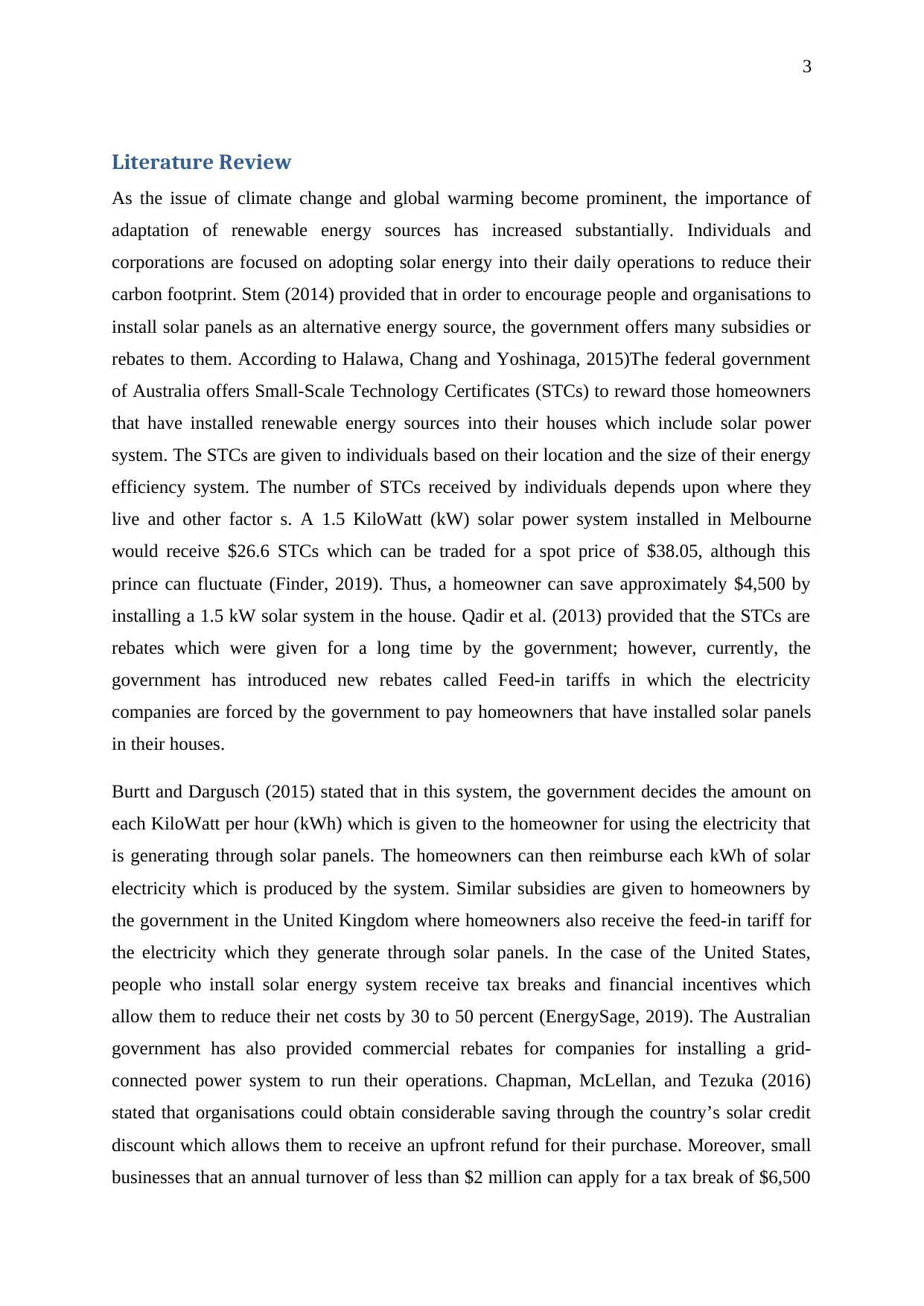
3
Literature Review
As the issue of climate change and global warming become prominent, the importance of
adaptation of renewable energy sources has increased substantially. Individuals and
corporations are focused on adopting solar energy into their daily operations to reduce their
carbon footprint. Stem (2014) provided that in order to encourage people and organisations to
install solar panels as an alternative energy source, the government offers many subsidies or
rebates to them. According to Halawa, Chang and Yoshinaga, 2015)The federal government
of Australia offers Small-Scale Technology Certificates (STCs) to reward those homeowners
that have installed renewable energy sources into their houses which include solar power
system. The STCs are given to individuals based on their location and the size of their energy
efficiency system. The number of STCs received by individuals depends upon where they
live and other factor s. A 1.5 KiloWatt (kW) solar power system installed in Melbourne
would receive $26.6 STCs which can be traded for a spot price of $38.05, although this
prince can fluctuate (Finder, 2019). Thus, a homeowner can save approximately $4,500 by
installing a 1.5 kW solar system in the house. Qadir et al. (2013) provided that the STCs are
rebates which were given for a long time by the government; however, currently, the
government has introduced new rebates called Feed-in tariffs in which the electricity
companies are forced by the government to pay homeowners that have installed solar panels
in their houses.
Burtt and Dargusch (2015) stated that in this system, the government decides the amount on
each KiloWatt per hour (kWh) which is given to the homeowner for using the electricity that
is generating through solar panels. The homeowners can then reimburse each kWh of solar
electricity which is produced by the system. Similar subsidies are given to homeowners by
the government in the United Kingdom where homeowners also receive the feed-in tariff for
the electricity which they generate through solar panels. In the case of the United States,
people who install solar energy system receive tax breaks and financial incentives which
allow them to reduce their net costs by 30 to 50 percent (EnergySage, 2019). The Australian
government has also provided commercial rebates for companies for installing a grid-
connected power system to run their operations. Chapman, McLellan, and Tezuka (2016)
stated that organisations could obtain considerable saving through the country’s solar credit
discount which allows them to receive an upfront refund for their purchase. Moreover, small
businesses that an annual turnover of less than $2 million can apply for a tax break of $6,500
Literature Review
As the issue of climate change and global warming become prominent, the importance of
adaptation of renewable energy sources has increased substantially. Individuals and
corporations are focused on adopting solar energy into their daily operations to reduce their
carbon footprint. Stem (2014) provided that in order to encourage people and organisations to
install solar panels as an alternative energy source, the government offers many subsidies or
rebates to them. According to Halawa, Chang and Yoshinaga, 2015)The federal government
of Australia offers Small-Scale Technology Certificates (STCs) to reward those homeowners
that have installed renewable energy sources into their houses which include solar power
system. The STCs are given to individuals based on their location and the size of their energy
efficiency system. The number of STCs received by individuals depends upon where they
live and other factor s. A 1.5 KiloWatt (kW) solar power system installed in Melbourne
would receive $26.6 STCs which can be traded for a spot price of $38.05, although this
prince can fluctuate (Finder, 2019). Thus, a homeowner can save approximately $4,500 by
installing a 1.5 kW solar system in the house. Qadir et al. (2013) provided that the STCs are
rebates which were given for a long time by the government; however, currently, the
government has introduced new rebates called Feed-in tariffs in which the electricity
companies are forced by the government to pay homeowners that have installed solar panels
in their houses.
Burtt and Dargusch (2015) stated that in this system, the government decides the amount on
each KiloWatt per hour (kWh) which is given to the homeowner for using the electricity that
is generating through solar panels. The homeowners can then reimburse each kWh of solar
electricity which is produced by the system. Similar subsidies are given to homeowners by
the government in the United Kingdom where homeowners also receive the feed-in tariff for
the electricity which they generate through solar panels. In the case of the United States,
people who install solar energy system receive tax breaks and financial incentives which
allow them to reduce their net costs by 30 to 50 percent (EnergySage, 2019). The Australian
government has also provided commercial rebates for companies for installing a grid-
connected power system to run their operations. Chapman, McLellan, and Tezuka (2016)
stated that organisations could obtain considerable saving through the country’s solar credit
discount which allows them to receive an upfront refund for their purchase. Moreover, small
businesses that an annual turnover of less than $2 million can apply for a tax break of $6,500
Secure Best Marks with AI Grader
Need help grading? Try our AI Grader for instant feedback on your assignments.

4
for installing a solar power system(Finder, 2019). Furthermore, these companies also receive
the facility of STCs and feed-in tariffs that enable them to earn surplus for generating
electricity through solar panels. In the case of the United States, companies receive a 30
percent investment credit for installing commercial solar systems in their
operations(EnergySage, 2019). These rebates are targeted on achieving a single goal which is
to increase the number of the solar energy system in countries to reduce the use of fossil fuel
and reduce carbon emissions by promoting the use of renewable energy by increasing the
sales of solar panels.
Customers and companies positively accepted the rebates/subsidies paid by the government
since it enables them to contribute to the protection of the environment as well. Byrnes et al.
(2013) provided that due to these rebates and subsidies, individuals and companies are
encouraged to invest in renewable energy sources such as solar energy which is crucial to
address the threat of climate change. In 2019, there is over 11,085 MW of installed
photovoltaic (PV) solar power available in Australia from which 3,871 MW were installed in
2018 (Energy Matters, 2019). As per Stevenson (2019), in 2017, solar energy contributes to
3.8 percent to the total Australian electrical energy production, and this number increased to
10.8 percent in 2018 which shows a substantial increase the use of solar energy by consumers
and companies. Martin and Rice (2013) argued that the actions taken by the government to
support the installation of solar energy production have been successful which should be
improved in the future to ensure that Australia becomes a leading country in terms of
production of solar energy. Since the solar energy benefits parties, in the long run, the
rebates and subsidies assist customers and companies in installing them in their operations to
ensure that they are able to take advantage of these factors for a long period of time.
The introduction of these rebates and subsidies has benefits because the sales of solar panels
have increased in Australia. In 2018, over 11.5 million solar panels were installed in the
country which includes rooftop panels and large scale solar farms (Gifford, 2019). It is
predicted that more than 13 million individual solar panels are produced in the country. As
per the federal government, a record of 3.5 million solar panels is installed by businesses and
homes in 2017 alone and this number has increased substantially. Ferrari et al. (2012)
provided that the average solar system size in Australia has increased by 200 percent as a
resulted in a reduction in the prices, advancement of technology and rebates program by the
government. South Australia has the most number of solar panels installed by individuals and
businesses as over 16,042 solar panels are installed in January 2018 (Figure 1).
for installing a solar power system(Finder, 2019). Furthermore, these companies also receive
the facility of STCs and feed-in tariffs that enable them to earn surplus for generating
electricity through solar panels. In the case of the United States, companies receive a 30
percent investment credit for installing commercial solar systems in their
operations(EnergySage, 2019). These rebates are targeted on achieving a single goal which is
to increase the number of the solar energy system in countries to reduce the use of fossil fuel
and reduce carbon emissions by promoting the use of renewable energy by increasing the
sales of solar panels.
Customers and companies positively accepted the rebates/subsidies paid by the government
since it enables them to contribute to the protection of the environment as well. Byrnes et al.
(2013) provided that due to these rebates and subsidies, individuals and companies are
encouraged to invest in renewable energy sources such as solar energy which is crucial to
address the threat of climate change. In 2019, there is over 11,085 MW of installed
photovoltaic (PV) solar power available in Australia from which 3,871 MW were installed in
2018 (Energy Matters, 2019). As per Stevenson (2019), in 2017, solar energy contributes to
3.8 percent to the total Australian electrical energy production, and this number increased to
10.8 percent in 2018 which shows a substantial increase the use of solar energy by consumers
and companies. Martin and Rice (2013) argued that the actions taken by the government to
support the installation of solar energy production have been successful which should be
improved in the future to ensure that Australia becomes a leading country in terms of
production of solar energy. Since the solar energy benefits parties, in the long run, the
rebates and subsidies assist customers and companies in installing them in their operations to
ensure that they are able to take advantage of these factors for a long period of time.
The introduction of these rebates and subsidies has benefits because the sales of solar panels
have increased in Australia. In 2018, over 11.5 million solar panels were installed in the
country which includes rooftop panels and large scale solar farms (Gifford, 2019). It is
predicted that more than 13 million individual solar panels are produced in the country. As
per the federal government, a record of 3.5 million solar panels is installed by businesses and
homes in 2017 alone and this number has increased substantially. Ferrari et al. (2012)
provided that the average solar system size in Australia has increased by 200 percent as a
resulted in a reduction in the prices, advancement of technology and rebates program by the
government. South Australia has the most number of solar panels installed by individuals and
businesses as over 16,042 solar panels are installed in January 2018 (Figure 1).
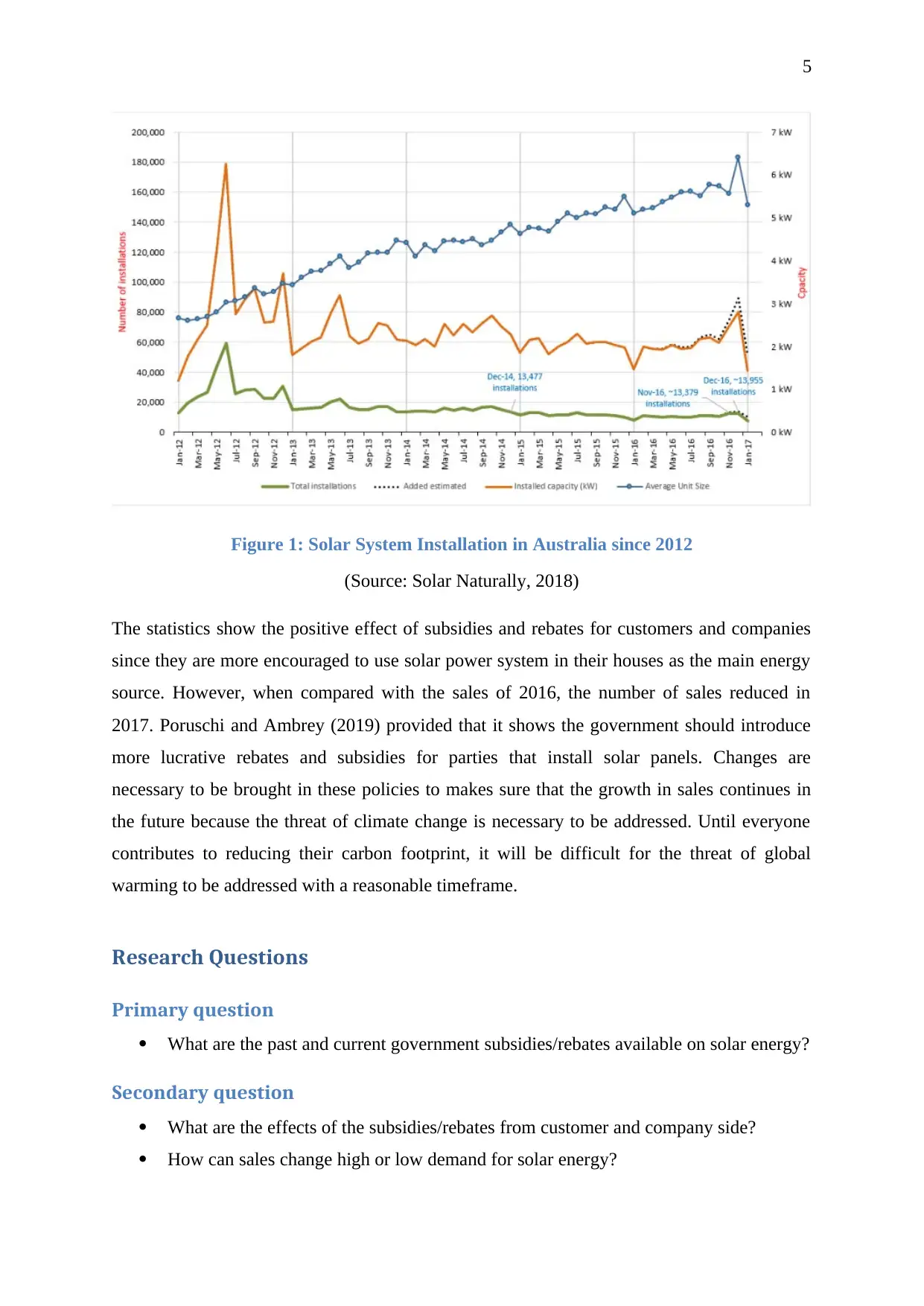
5
Figure 1: Solar System Installation in Australia since 2012
(Source: Solar Naturally, 2018)
The statistics show the positive effect of subsidies and rebates for customers and companies
since they are more encouraged to use solar power system in their houses as the main energy
source. However, when compared with the sales of 2016, the number of sales reduced in
2017. Poruschi and Ambrey (2019) provided that it shows the government should introduce
more lucrative rebates and subsidies for parties that install solar panels. Changes are
necessary to be brought in these policies to makes sure that the growth in sales continues in
the future because the threat of climate change is necessary to be addressed. Until everyone
contributes to reducing their carbon footprint, it will be difficult for the threat of global
warming to be addressed with a reasonable timeframe.
Research Questions
Primary question
What are the past and current government subsidies/rebates available on solar energy?
Secondary question
What are the effects of the subsidies/rebates from customer and company side?
How can sales change high or low demand for solar energy?
Figure 1: Solar System Installation in Australia since 2012
(Source: Solar Naturally, 2018)
The statistics show the positive effect of subsidies and rebates for customers and companies
since they are more encouraged to use solar power system in their houses as the main energy
source. However, when compared with the sales of 2016, the number of sales reduced in
2017. Poruschi and Ambrey (2019) provided that it shows the government should introduce
more lucrative rebates and subsidies for parties that install solar panels. Changes are
necessary to be brought in these policies to makes sure that the growth in sales continues in
the future because the threat of climate change is necessary to be addressed. Until everyone
contributes to reducing their carbon footprint, it will be difficult for the threat of global
warming to be addressed with a reasonable timeframe.
Research Questions
Primary question
What are the past and current government subsidies/rebates available on solar energy?
Secondary question
What are the effects of the subsidies/rebates from customer and company side?
How can sales change high or low demand for solar energy?
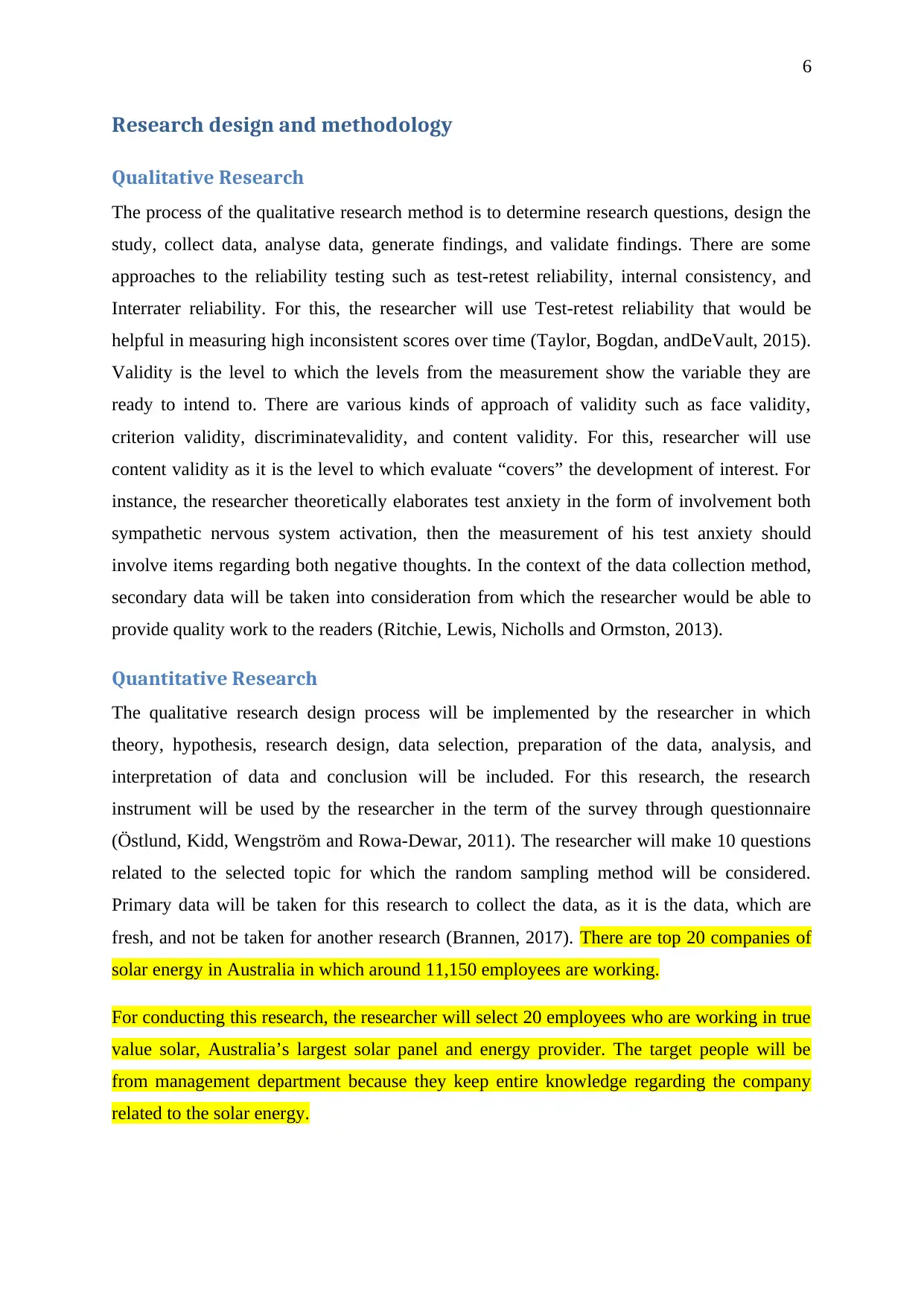
6
Research design and methodology
Qualitative Research
The process of the qualitative research method is to determine research questions, design the
study, collect data, analyse data, generate findings, and validate findings. There are some
approaches to the reliability testing such as test-retest reliability, internal consistency, and
Interrater reliability. For this, the researcher will use Test-retest reliability that would be
helpful in measuring high inconsistent scores over time (Taylor, Bogdan, andDeVault, 2015).
Validity is the level to which the levels from the measurement show the variable they are
ready to intend to. There are various kinds of approach of validity such as face validity,
criterion validity, discriminatevalidity, and content validity. For this, researcher will use
content validity as it is the level to which evaluate “covers” the development of interest. For
instance, the researcher theoretically elaborates test anxiety in the form of involvement both
sympathetic nervous system activation, then the measurement of his test anxiety should
involve items regarding both negative thoughts. In the context of the data collection method,
secondary data will be taken into consideration from which the researcher would be able to
provide quality work to the readers (Ritchie, Lewis, Nicholls and Ormston, 2013).
Quantitative Research
The qualitative research design process will be implemented by the researcher in which
theory, hypothesis, research design, data selection, preparation of the data, analysis, and
interpretation of data and conclusion will be included. For this research, the research
instrument will be used by the researcher in the term of the survey through questionnaire
(Östlund, Kidd, Wengström and Rowa-Dewar, 2011). The researcher will make 10 questions
related to the selected topic for which the random sampling method will be considered.
Primary data will be taken for this research to collect the data, as it is the data, which are
fresh, and not be taken for another research (Brannen, 2017). There are top 20 companies of
solar energy in Australia in which around 11,150 employees are working.
For conducting this research, the researcher will select 20 employees who are working in true
value solar, Australia’s largest solar panel and energy provider. The target people will be
from management department because they keep entire knowledge regarding the company
related to the solar energy.
Research design and methodology
Qualitative Research
The process of the qualitative research method is to determine research questions, design the
study, collect data, analyse data, generate findings, and validate findings. There are some
approaches to the reliability testing such as test-retest reliability, internal consistency, and
Interrater reliability. For this, the researcher will use Test-retest reliability that would be
helpful in measuring high inconsistent scores over time (Taylor, Bogdan, andDeVault, 2015).
Validity is the level to which the levels from the measurement show the variable they are
ready to intend to. There are various kinds of approach of validity such as face validity,
criterion validity, discriminatevalidity, and content validity. For this, researcher will use
content validity as it is the level to which evaluate “covers” the development of interest. For
instance, the researcher theoretically elaborates test anxiety in the form of involvement both
sympathetic nervous system activation, then the measurement of his test anxiety should
involve items regarding both negative thoughts. In the context of the data collection method,
secondary data will be taken into consideration from which the researcher would be able to
provide quality work to the readers (Ritchie, Lewis, Nicholls and Ormston, 2013).
Quantitative Research
The qualitative research design process will be implemented by the researcher in which
theory, hypothesis, research design, data selection, preparation of the data, analysis, and
interpretation of data and conclusion will be included. For this research, the research
instrument will be used by the researcher in the term of the survey through questionnaire
(Östlund, Kidd, Wengström and Rowa-Dewar, 2011). The researcher will make 10 questions
related to the selected topic for which the random sampling method will be considered.
Primary data will be taken for this research to collect the data, as it is the data, which are
fresh, and not be taken for another research (Brannen, 2017). There are top 20 companies of
solar energy in Australia in which around 11,150 employees are working.
For conducting this research, the researcher will select 20 employees who are working in true
value solar, Australia’s largest solar panel and energy provider. The target people will be
from management department because they keep entire knowledge regarding the company
related to the solar energy.
Paraphrase This Document
Need a fresh take? Get an instant paraphrase of this document with our AI Paraphraser

7
Further, the population working at Australian company is diversified as it included migrated
employees. The researcher will locate them by approach of voluntary in which they can
represent themselves to take participation in research. Researcher will select only those
employees who are interested in participating to answer the questions regarding current
research topic. The questionnaire will be associated with the scope of the solar energy
industry in the present market. Random sampling method is used by the researcher to select
the participants who will conduct the research. The interview will be considered by the
researcher to selected people for which the questions related to the selected topic will be
asked to them so that an appropriate action can be taken within the research. To analyse this
study, the researcher will use statistical data analysis method and content data analysis
method to evaluate numerical as well as theoretical data.
Potential findings
Researcher will be conducting the research to comprehend the scope of the solar energy
industry in the present market.It will also support researcher to find sort of challenges is faced
by in implementation of solar energy technologies. Further, it will also help to get better
understanding regarding the contribution of different countries in the solar energy industry.
This research will highlight different government policies that could be effective in the
growth of solar energy industry.
Research Limitations
In the context of the research limitations, it can be said that there are activities that are
practice as limitation and influenced execution process of program in the research. The big
limitation for this research is short span of time. Along with the lack of access of the data and
the resources are the limitations of this research. The sampling size could be increased in the
context of collecting the data in huge manner.
Time Schedule
Serial
no.
Activities Initiation date Duration
(days)
Completion date
1) Topic Selection 16th February 2019 2 18th February 2019
Further, the population working at Australian company is diversified as it included migrated
employees. The researcher will locate them by approach of voluntary in which they can
represent themselves to take participation in research. Researcher will select only those
employees who are interested in participating to answer the questions regarding current
research topic. The questionnaire will be associated with the scope of the solar energy
industry in the present market. Random sampling method is used by the researcher to select
the participants who will conduct the research. The interview will be considered by the
researcher to selected people for which the questions related to the selected topic will be
asked to them so that an appropriate action can be taken within the research. To analyse this
study, the researcher will use statistical data analysis method and content data analysis
method to evaluate numerical as well as theoretical data.
Potential findings
Researcher will be conducting the research to comprehend the scope of the solar energy
industry in the present market.It will also support researcher to find sort of challenges is faced
by in implementation of solar energy technologies. Further, it will also help to get better
understanding regarding the contribution of different countries in the solar energy industry.
This research will highlight different government policies that could be effective in the
growth of solar energy industry.
Research Limitations
In the context of the research limitations, it can be said that there are activities that are
practice as limitation and influenced execution process of program in the research. The big
limitation for this research is short span of time. Along with the lack of access of the data and
the resources are the limitations of this research. The sampling size could be increased in the
context of collecting the data in huge manner.
Time Schedule
Serial
no.
Activities Initiation date Duration
(days)
Completion date
1) Topic Selection 16th February 2019 2 18th February 2019
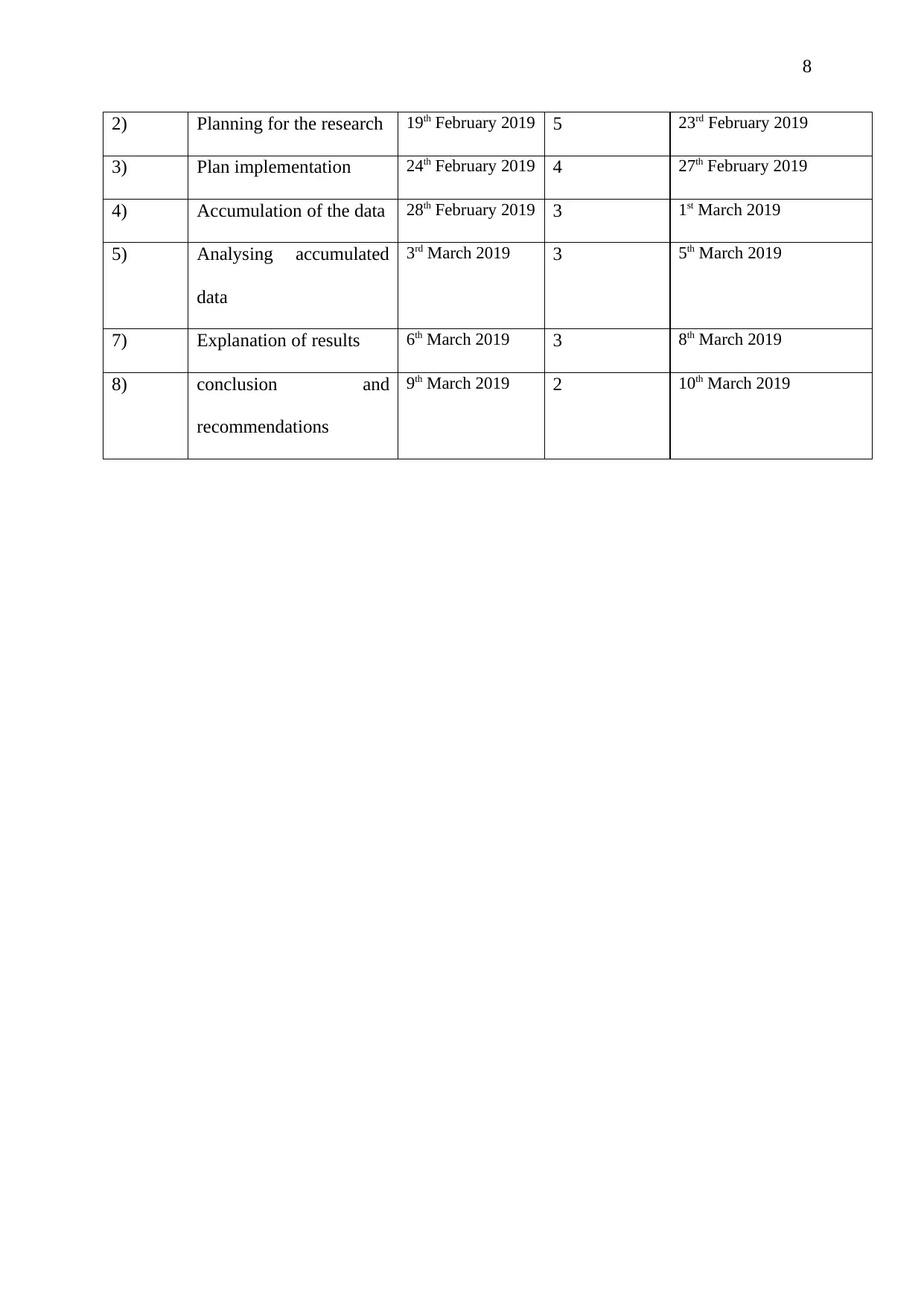
8
2) Planning for the research 19th February 2019 5 23rd February 2019
3) Plan implementation 24th February 2019 4 27th February 2019
4) Accumulation of the data 28th February 2019 3 1st March 2019
5) Analysing accumulated
data
3rd March 2019 3 5th March 2019
7) Explanation of results 6th March 2019 3 8th March 2019
8) conclusion and
recommendations
9th March 2019 2 10th March 2019
2) Planning for the research 19th February 2019 5 23rd February 2019
3) Plan implementation 24th February 2019 4 27th February 2019
4) Accumulation of the data 28th February 2019 3 1st March 2019
5) Analysing accumulated
data
3rd March 2019 3 5th March 2019
7) Explanation of results 6th March 2019 3 8th March 2019
8) conclusion and
recommendations
9th March 2019 2 10th March 2019
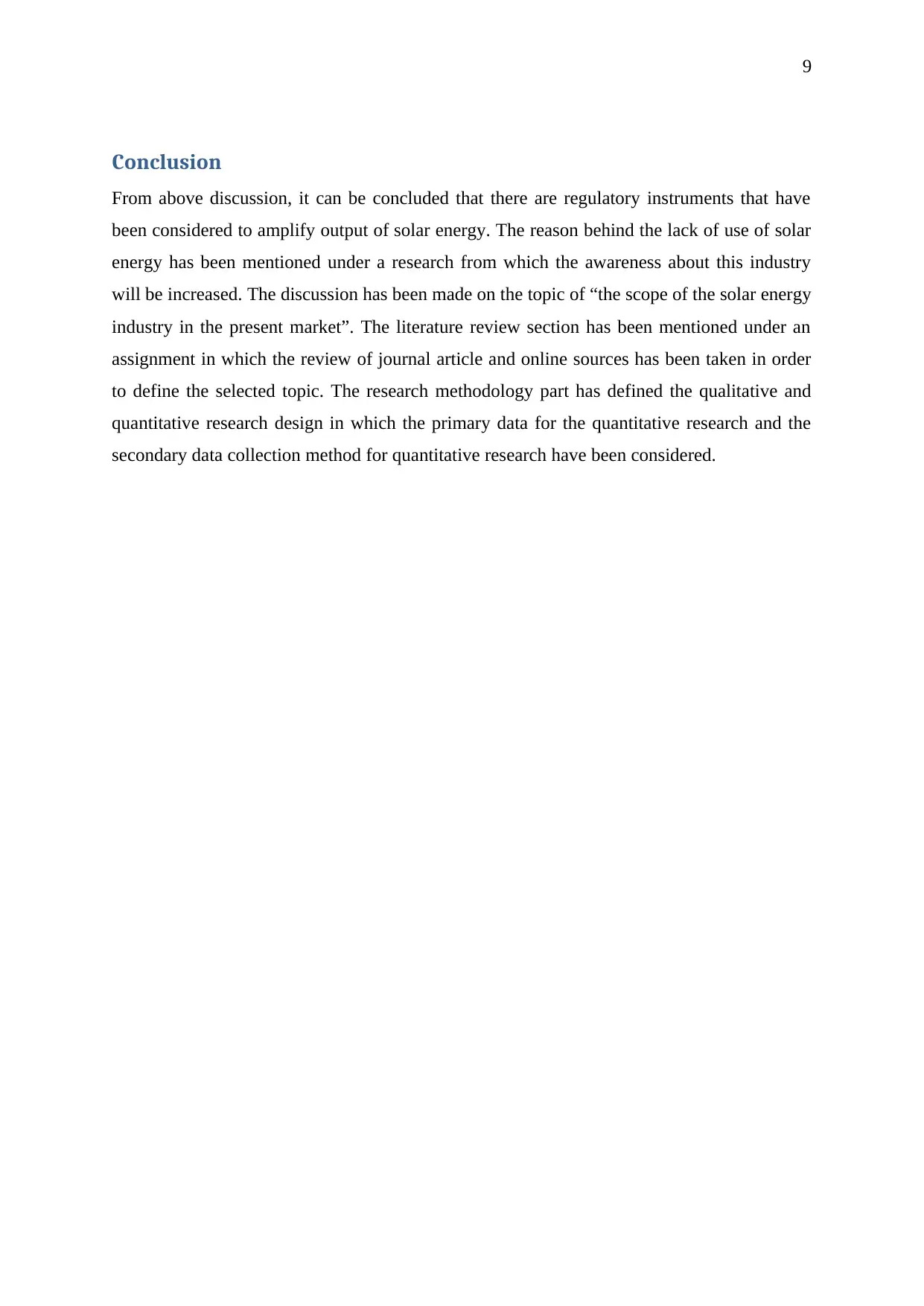
9
Conclusion
From above discussion, it can be concluded that there are regulatory instruments that have
been considered to amplify output of solar energy. The reason behind the lack of use of solar
energy has been mentioned under a research from which the awareness about this industry
will be increased. The discussion has been made on the topic of “the scope of the solar energy
industry in the present market”. The literature review section has been mentioned under an
assignment in which the review of journal article and online sources has been taken in order
to define the selected topic. The research methodology part has defined the qualitative and
quantitative research design in which the primary data for the quantitative research and the
secondary data collection method for quantitative research have been considered.
Conclusion
From above discussion, it can be concluded that there are regulatory instruments that have
been considered to amplify output of solar energy. The reason behind the lack of use of solar
energy has been mentioned under a research from which the awareness about this industry
will be increased. The discussion has been made on the topic of “the scope of the solar energy
industry in the present market”. The literature review section has been mentioned under an
assignment in which the review of journal article and online sources has been taken in order
to define the selected topic. The research methodology part has defined the qualitative and
quantitative research design in which the primary data for the quantitative research and the
secondary data collection method for quantitative research have been considered.
Secure Best Marks with AI Grader
Need help grading? Try our AI Grader for instant feedback on your assignments.
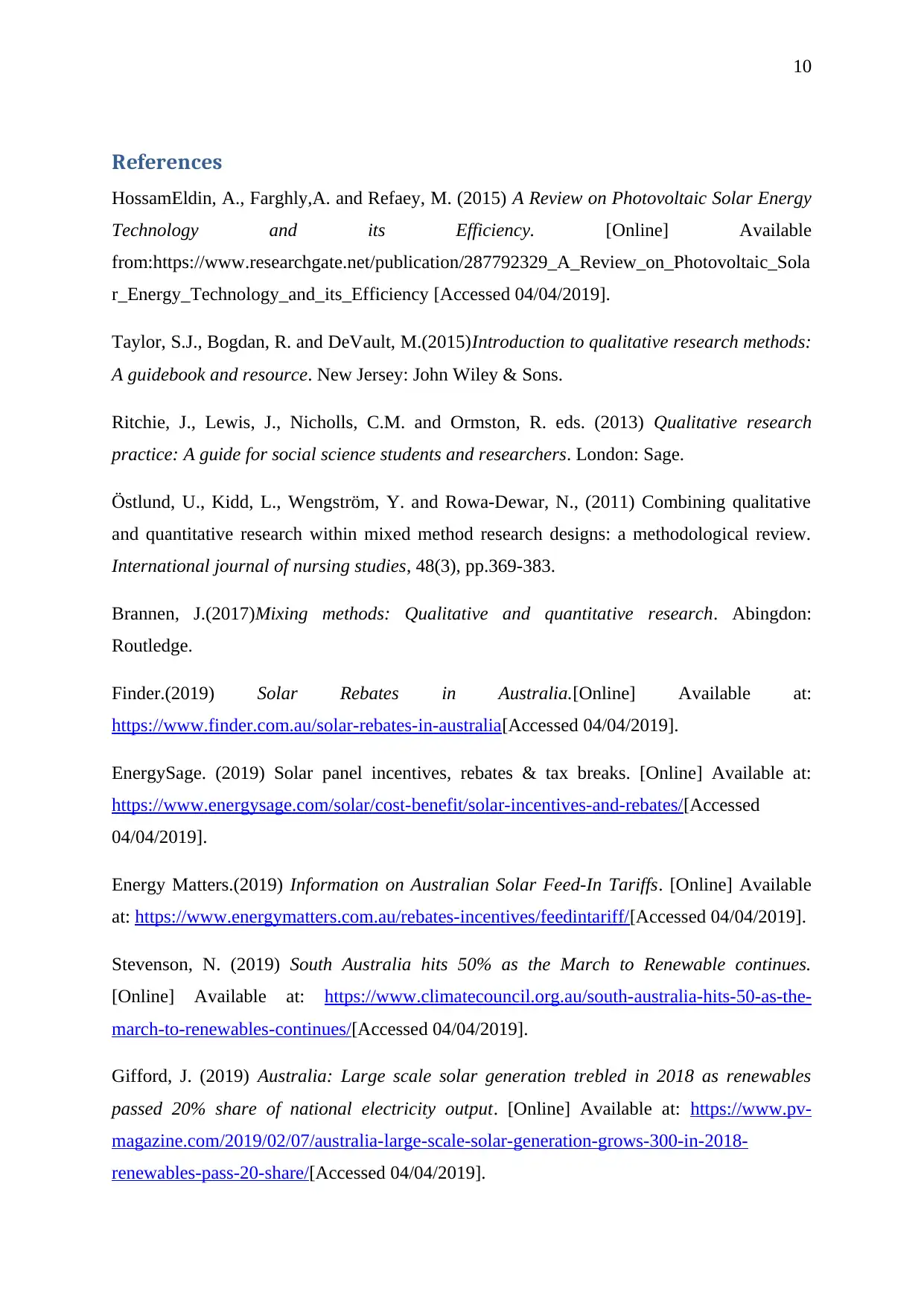
10
References
HossamEldin, A., Farghly,A. and Refaey, M. (2015) A Review on Photovoltaic Solar Energy
Technology and its Efficiency. [Online] Available
from:https://www.researchgate.net/publication/287792329_A_Review_on_Photovoltaic_Sola
r_Energy_Technology_and_its_Efficiency [Accessed 04/04/2019].
Taylor, S.J., Bogdan, R. and DeVault, M.(2015)Introduction to qualitative research methods:
A guidebook and resource. New Jersey: John Wiley & Sons.
Ritchie, J., Lewis, J., Nicholls, C.M. and Ormston, R. eds. (2013) Qualitative research
practice: A guide for social science students and researchers. London: Sage.
Östlund, U., Kidd, L., Wengström, Y. and Rowa-Dewar, N., (2011) Combining qualitative
and quantitative research within mixed method research designs: a methodological review.
International journal of nursing studies, 48(3), pp.369-383.
Brannen, J.(2017)Mixing methods: Qualitative and quantitative research. Abingdon:
Routledge.
Finder.(2019) Solar Rebates in Australia.[Online] Available at:
https://www.finder.com.au/solar-rebates-in-australia[Accessed 04/04/2019].
EnergySage. (2019) Solar panel incentives, rebates & tax breaks. [Online] Available at:
https://www.energysage.com/solar/cost-benefit/solar-incentives-and-rebates/[Accessed
04/04/2019].
Energy Matters.(2019) Information on Australian Solar Feed-In Tariffs. [Online] Available
at: https://www.energymatters.com.au/rebates-incentives/feedintariff/[Accessed 04/04/2019].
Stevenson, N. (2019) South Australia hits 50% as the March to Renewable continues.
[Online] Available at: https://www.climatecouncil.org.au/south-australia-hits-50-as-the-
march-to-renewables-continues/[Accessed 04/04/2019].
Gifford, J. (2019) Australia: Large scale solar generation trebled in 2018 as renewables
passed 20% share of national electricity output. [Online] Available at: https://www.pv-
magazine.com/2019/02/07/australia-large-scale-solar-generation-grows-300-in-2018-
renewables-pass-20-share/[Accessed 04/04/2019].
References
HossamEldin, A., Farghly,A. and Refaey, M. (2015) A Review on Photovoltaic Solar Energy
Technology and its Efficiency. [Online] Available
from:https://www.researchgate.net/publication/287792329_A_Review_on_Photovoltaic_Sola
r_Energy_Technology_and_its_Efficiency [Accessed 04/04/2019].
Taylor, S.J., Bogdan, R. and DeVault, M.(2015)Introduction to qualitative research methods:
A guidebook and resource. New Jersey: John Wiley & Sons.
Ritchie, J., Lewis, J., Nicholls, C.M. and Ormston, R. eds. (2013) Qualitative research
practice: A guide for social science students and researchers. London: Sage.
Östlund, U., Kidd, L., Wengström, Y. and Rowa-Dewar, N., (2011) Combining qualitative
and quantitative research within mixed method research designs: a methodological review.
International journal of nursing studies, 48(3), pp.369-383.
Brannen, J.(2017)Mixing methods: Qualitative and quantitative research. Abingdon:
Routledge.
Finder.(2019) Solar Rebates in Australia.[Online] Available at:
https://www.finder.com.au/solar-rebates-in-australia[Accessed 04/04/2019].
EnergySage. (2019) Solar panel incentives, rebates & tax breaks. [Online] Available at:
https://www.energysage.com/solar/cost-benefit/solar-incentives-and-rebates/[Accessed
04/04/2019].
Energy Matters.(2019) Information on Australian Solar Feed-In Tariffs. [Online] Available
at: https://www.energymatters.com.au/rebates-incentives/feedintariff/[Accessed 04/04/2019].
Stevenson, N. (2019) South Australia hits 50% as the March to Renewable continues.
[Online] Available at: https://www.climatecouncil.org.au/south-australia-hits-50-as-the-
march-to-renewables-continues/[Accessed 04/04/2019].
Gifford, J. (2019) Australia: Large scale solar generation trebled in 2018 as renewables
passed 20% share of national electricity output. [Online] Available at: https://www.pv-
magazine.com/2019/02/07/australia-large-scale-solar-generation-grows-300-in-2018-
renewables-pass-20-share/[Accessed 04/04/2019].
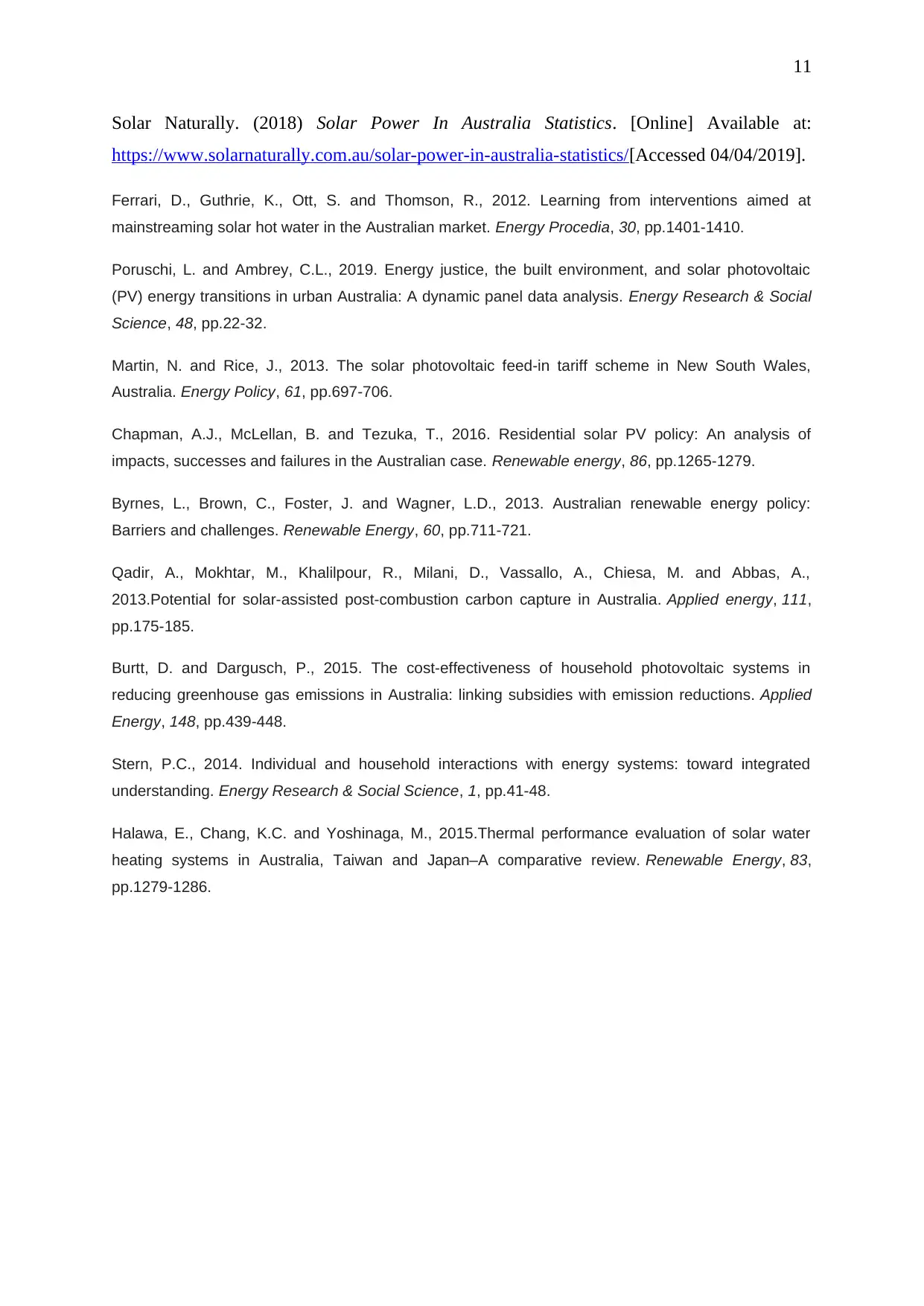
11
Solar Naturally. (2018) Solar Power In Australia Statistics. [Online] Available at:
https://www.solarnaturally.com.au/solar-power-in-australia-statistics/[Accessed 04/04/2019].
Ferrari, D., Guthrie, K., Ott, S. and Thomson, R., 2012. Learning from interventions aimed at
mainstreaming solar hot water in the Australian market. Energy Procedia, 30, pp.1401-1410.
Poruschi, L. and Ambrey, C.L., 2019. Energy justice, the built environment, and solar photovoltaic
(PV) energy transitions in urban Australia: A dynamic panel data analysis. Energy Research & Social
Science, 48, pp.22-32.
Martin, N. and Rice, J., 2013. The solar photovoltaic feed-in tariff scheme in New South Wales,
Australia. Energy Policy, 61, pp.697-706.
Chapman, A.J., McLellan, B. and Tezuka, T., 2016. Residential solar PV policy: An analysis of
impacts, successes and failures in the Australian case. Renewable energy, 86, pp.1265-1279.
Byrnes, L., Brown, C., Foster, J. and Wagner, L.D., 2013. Australian renewable energy policy:
Barriers and challenges. Renewable Energy, 60, pp.711-721.
Qadir, A., Mokhtar, M., Khalilpour, R., Milani, D., Vassallo, A., Chiesa, M. and Abbas, A.,
2013.Potential for solar-assisted post-combustion carbon capture in Australia. Applied energy, 111,
pp.175-185.
Burtt, D. and Dargusch, P., 2015. The cost-effectiveness of household photovoltaic systems in
reducing greenhouse gas emissions in Australia: linking subsidies with emission reductions. Applied
Energy, 148, pp.439-448.
Stern, P.C., 2014. Individual and household interactions with energy systems: toward integrated
understanding. Energy Research & Social Science, 1, pp.41-48.
Halawa, E., Chang, K.C. and Yoshinaga, M., 2015.Thermal performance evaluation of solar water
heating systems in Australia, Taiwan and Japan–A comparative review. Renewable Energy, 83,
pp.1279-1286.
Solar Naturally. (2018) Solar Power In Australia Statistics. [Online] Available at:
https://www.solarnaturally.com.au/solar-power-in-australia-statistics/[Accessed 04/04/2019].
Ferrari, D., Guthrie, K., Ott, S. and Thomson, R., 2012. Learning from interventions aimed at
mainstreaming solar hot water in the Australian market. Energy Procedia, 30, pp.1401-1410.
Poruschi, L. and Ambrey, C.L., 2019. Energy justice, the built environment, and solar photovoltaic
(PV) energy transitions in urban Australia: A dynamic panel data analysis. Energy Research & Social
Science, 48, pp.22-32.
Martin, N. and Rice, J., 2013. The solar photovoltaic feed-in tariff scheme in New South Wales,
Australia. Energy Policy, 61, pp.697-706.
Chapman, A.J., McLellan, B. and Tezuka, T., 2016. Residential solar PV policy: An analysis of
impacts, successes and failures in the Australian case. Renewable energy, 86, pp.1265-1279.
Byrnes, L., Brown, C., Foster, J. and Wagner, L.D., 2013. Australian renewable energy policy:
Barriers and challenges. Renewable Energy, 60, pp.711-721.
Qadir, A., Mokhtar, M., Khalilpour, R., Milani, D., Vassallo, A., Chiesa, M. and Abbas, A.,
2013.Potential for solar-assisted post-combustion carbon capture in Australia. Applied energy, 111,
pp.175-185.
Burtt, D. and Dargusch, P., 2015. The cost-effectiveness of household photovoltaic systems in
reducing greenhouse gas emissions in Australia: linking subsidies with emission reductions. Applied
Energy, 148, pp.439-448.
Stern, P.C., 2014. Individual and household interactions with energy systems: toward integrated
understanding. Energy Research & Social Science, 1, pp.41-48.
Halawa, E., Chang, K.C. and Yoshinaga, M., 2015.Thermal performance evaluation of solar water
heating systems in Australia, Taiwan and Japan–A comparative review. Renewable Energy, 83,
pp.1279-1286.
1 out of 12
Related Documents
Your All-in-One AI-Powered Toolkit for Academic Success.
+13062052269
info@desklib.com
Available 24*7 on WhatsApp / Email
![[object Object]](/_next/static/media/star-bottom.7253800d.svg)
Unlock your academic potential
© 2024 | Zucol Services PVT LTD | All rights reserved.





